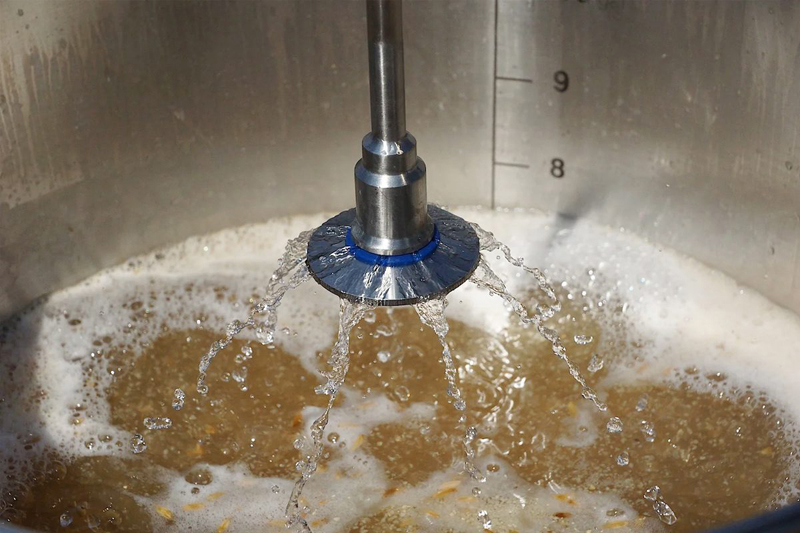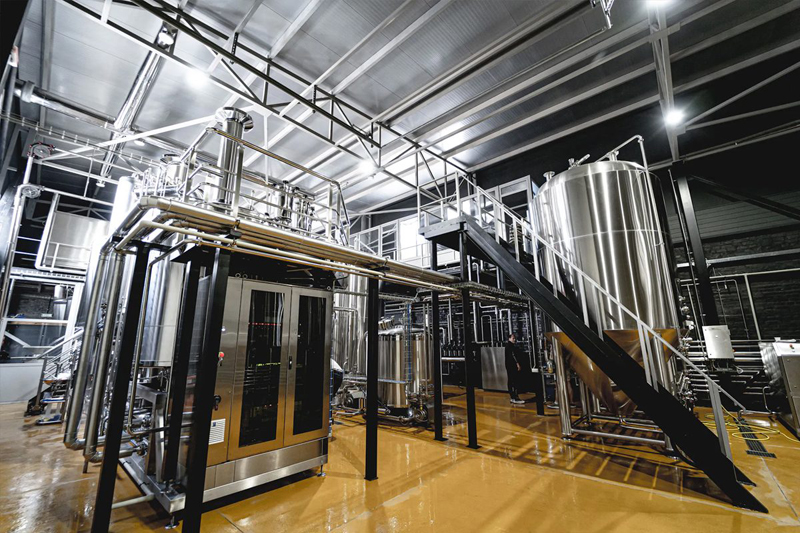The Importance of Mashing Process in Brewing
Mashing is a fundamental step in the beer brewing process, where the foundation of the beer’s flavor, body, and alcohol content is established. It's during mashing that the raw materials, primarily malted grains, are transformed through enzymatic reactions to produce fermentable sugars, which will later be converted into alcohol by yeast. This critical step, which occurs after the milling of grains and before the boiling of the wort, plays a significant role in determining the final character of the beer. The importance of mashing cannot be overstated, as it impacts everything from the efficiency of sugar extraction to the complexity of the beer’s flavor profile.
1.The Role of Mashing in Flavor Development
2.The Impact of Mashing on Beer Styles
3.Troubleshooting Common Mashing Issues
4.Innovations and Modern Techniques in Mashing
5.The Future of Mashing in Brewing
6.Summary
I.The Role of Mashing in Flavor Development
Mashing plays a pivotal role in defining the flavor profile of the beer. The enzymatic breakdown of starches and proteins, as well as the extraction of other compounds from the malt, directly influences the sweetness, mouthfeel, and overall complexity of the beer.
Maillard Reactions
During the mashing process, especially in decoction mashing, Maillard reactions can occur. These are chemical reactions between amino acids and reducing sugars that produce a range of flavor and color compounds. The Maillard reaction is responsible for creating the rich, malty flavors found in many darker beers. While these reactions occur more extensively during boiling, the groundwork is laid during mashing, particularly if high temperatures are used.
Extraction of Polyphenols
Polyphenols, also known as tannins, are extracted from the malt husks during mashing. While some polyphenols are desirable for their antioxidant properties and contribution to the mouthfeel, excessive extraction, often due to high mash pH or excessive sparging, can lead to astringency and haze in the final beer.
Influence on Fermentation
The composition of the wort produced during mashing has a direct impact on fermentation. The balance of fermentable and non-fermentable sugars determines the beer’s final gravity, sweetness, and alcohol content. Additionally, free amino nitrogen (FAN) from protein breakdown contributes to healthy yeast growth and efficient fermentation. The well-executed mash ensures that the wort provides all the necessary nutrients for the yeast, leading to a smooth and complete fermentation.
II.The Impact of Mashing on Beer Styles
Different beer styles require different mashing techniques to achieve their characteristic flavors, body, and alcohol content. Understanding the relationship between mashing and beer styles is essential for brewers aiming to produce specific types of beer.
Light Lagers
Light lagers, such as Pilsners, require a mash that produces a highly fermentable wort, resulting in a clean, crisp beer with a light body. Single infusion mashing at the lower end of the temperature spectrum (around 148-152°F or 64-67°C) is often used to maximize beta-amylase activity, creating a wort rich in fermentable sugars. Additionally, the use of well-modified malts reduces the need for complex mashing techniques, as the malt itself provides the necessary enzymes and nutrients.
Dark Beers
Beers such as stouts, porters, and dark lagers benefit from more complex mashing techniques, such as step mashing or decoction mashing. These methods enhance the extraction of melanoidins and other flavor compounds, contributing to the rich, malty character of these beers. Higher mashing temperatures (around 154-158°F or 68-70°C) favor alpha-amylase activity, leading to a wort with more dextrins, which contribute to a fuller body and sweetness in the final beer.
Wheat Beers
Wheat beers, such as Hefeweizens, often require a different approach to mashing due to the high protein content of wheat. A protein rest at around 113-131°F (45-55°C) is commonly employed to break down proteins and reduce haze, resulting in a clearer beer with a stable head. Additionally, step mashing can be used to control the production of phenols, which contribute to the characteristic clove-like flavors in many wheat beers.
High-Gravity Beers
Brewing high-gravity beers, such as barleywines or imperial stouts, requires a mashing process that maximizes the extraction of fermentable sugars to achieve the desired high alcohol content. A long mash at a slightly lower temperature (around 146-150°F or 63-65°C) can increase the yield of fermentable sugars, while also producing a wort with enough body to balance the high alcohol content.
III.Troubleshooting Common Mashing Issues
Mashing is a delicate process, and even small deviations can lead to significant issues in the final beer. Understanding and solving common mashing problems can help produce consistent, high-quality beer.
Stuck Mash
A stuck mash occurs when the mash bed becomes compacted, preventing the liquid wort from draining through the grains. This can be caused by a variety of factors, including the use of high-protein malts, poor milling, or improper mash temperature. To prevent a stuck mash, brewers can ensure that the grain is milled correctly (not too fine), use a well-designed mash tun with good drainage, and consider adding rice hulls to the mash to improve flow.
Inconsistent Mash Temperature
Inconsistent mash temperature can lead to uneven enzyme activity, resulting in a wort with unpredictable sugar composition. This can occur due to poor insulation of the mash tun, incorrect temperature measurement, or inadequate stirring of the mash. To maintain a consistent temperature, brewers should preheat their mash tun, use a reliable thermometer, and stir the mash thoroughly to ensure even heat distribution.
Low Mash Efficiency
Mash efficiency refers to the percentage of potential fermentable sugars extracted from the malt. Low mash efficiency can result in a lower-than-expected original gravity, leading to a weaker beer. Causes of low mash efficiency include poor milling, incorrect mash pH, inadequate mash time, or insufficient enzyme activity. Brewers can improve mash efficiency by ensuring the grain is milled to the correct consistency, maintaining the mash pH within the optimal range (5.2-5.6), and allowing sufficient time for the enzymes to work.
Hazy Beer
Haze in the final beer can be caused by incomplete protein breakdown during mashing or by the presence of polyphenols. To reduce haze, brewers can perform a protein rest during mashing, ensure proper wort cooling, and consider using fining agents or cold conditioning to help clarify the beer.
IV.Innovations and Modern Techniques in Mashing
The brewing industry continually evolves, and mashing techniques have seen significant advancements in recent years. These innovations aim to improve efficiency, consistency, and the overall quality of the beer.
High-Efficiency Mashing Systems
Modern breweries often use high-efficiency mashing systems, such as mash filters or continuous mashing, to optimize the extraction of sugars and reduce processing time. Mash filters, for example, use pressure to extract more wort from the grain bed, resulting in higher efficiency and reduced water usage. Continuous mashing involves a steady flow of grain and water through a series of temperature-controlled vessels, allowing for precise control of the mashing process and reducing the time required to produce wort.
Enzyme Additions
In some cases, brewers may add commercial enzymes to the mash to enhance specific aspects of the process. These enzymes can help break down starches, proteins, or beta-glucans more efficiently, particularly when using adjuncts or less modified malts that might lack the necessary enzymatic activity. Enzyme additions are especially useful in large-scale brewing operations where consistency and efficiency are paramount.
pH Control
Maintaining the correct wort pH can help maintain optimal enzyme activity and improve overall beer quality. Innovations in pH control include the use of acidulated malt or food-grade acids (such as lactic or phosphoric acid) to adjust the mash pH precisely. Some breweries also use pH meters or automated systems to monitor and adjust pH in real-time during mashing, ensuring the process stays within the ideal range.
Decentralized Brewing Systems
Decentralized or modular brewing systems, which separate the mashing process from the rest of the brewing operation, have become more common in modern breweries. These systems allow brewers to mash multiple batches of beer simultaneously, increasing production efficiency and flexibility. By decoupling mashing from boiling and fermentation, breweries can produce a wider variety of beers without the need for additional brewhouse equipment.
Automation and Data-Driven Brewing
Automation has revolutionized the brewing industry, and mashing is no exception. Many modern breweries use fully automated systems to control every aspect of the mashing process, from temperature ramps to enzyme additions. These systems are often integrated with data collection tools that monitor the mash in real time, allowing brewers to make adjustments on the fly and maintain consistent quality across batches. Data-driven brewing also enables brewers to analyze past mashing data to optimize future recipes and processes.
V.The Future of Mashing in Brewing
As the brewing industry continues to evolve, the future of mashing is likely to be shaped by several key trends and innovations. These developments will impact not only how beer is produced but also the types of beers that are created.
Customization and Flexibility
Consumer demand for unique and personalized beers is driving breweries to explore more flexible mashing techniques. The ability to customize the mashing process, whether through variable temperature programs, the use of novel enzymes, or the incorporation of new ingredients, allows brewers to create distinctive beers that cater to specific tastes and preferences. This trend towards customization is likely to continue, with breweries investing in more adaptable mashing systems that can accommodate a wide range of brewing styles.
Sustainability and Resource Efficiency
Sustainability will continue to be a major focus for the brewing industry, and mashing is no exception. Breweries will increasingly seek to minimize the environmental impact of mashing by reducing water and energy consumption, optimizing spent grain management, and exploring new ways to recycle or repurpose byproducts. Innovations in brewing technology, such as more efficient mash filters or the use of alternative heating methods, will play a key role in achieving these sustainability goals.
Advanced Brewing Analytics
The use of advanced analytics and data-driven brewing techniques is expected to become more widespread in the coming years. By collecting and analyzing detailed data on the mashing process, brewers can gain deeper insights into the relationships between mash parameters and beer quality. This information can be used to optimize mashing techniques, improve consistency, and even predict the outcomes of new recipes. The integration of artificial intelligence and machine learning into brewing systems may further enhance the ability to fine-tune the mashing process.
Exploration of Non-Traditional Ingredients
As brewers continue to experiment with non-traditional ingredients, such as ancient grains, alternative cereals, and even unconventional starch sources, mashing techniques will need to adapt. The unique properties of these ingredients may require specialized mashing approaches, including different temperature schedules, enzyme additions, or pre-treatments. The exploration of these new ingredients will likely lead to the development of innovative mashing techniques that expand the possibilities of beer brewing.
VI.Summary
Mashing is undeniably one of the most critical steps in the beer brewing process. From its role in converting starches into fermentable sugars to its impact on flavor, body, and alcohol content, mashing sets the stage for the entire brewing process. The techniques and innovations in mashing have evolved significantly over the centuries, reflecting the continuous pursuit of better beer. As the brewing industry looks to the future, mashing will remain at the heart of beer production, driving the creation of new flavors, styles, and brewing techniques. Whether you’re a home-brewer trying to brew your first batch of beer or a professional brewer pushing the boundaries of beer production, you need to understand and master the mashing process to brew high-quality beer.
 Jinan Alston Equipment Co.,Ltd.
Jinan Alston Equipment Co.,Ltd.



